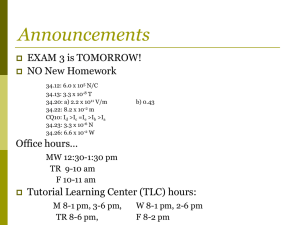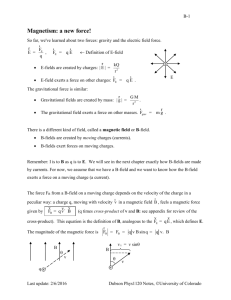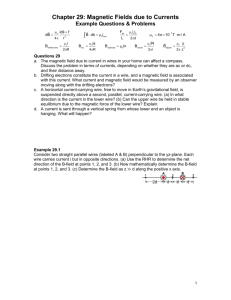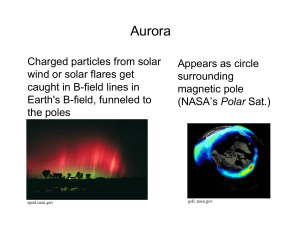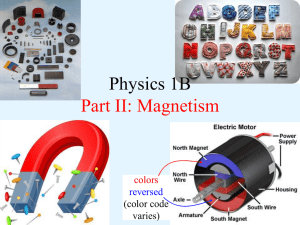Magnetism: a new force!
advertisement
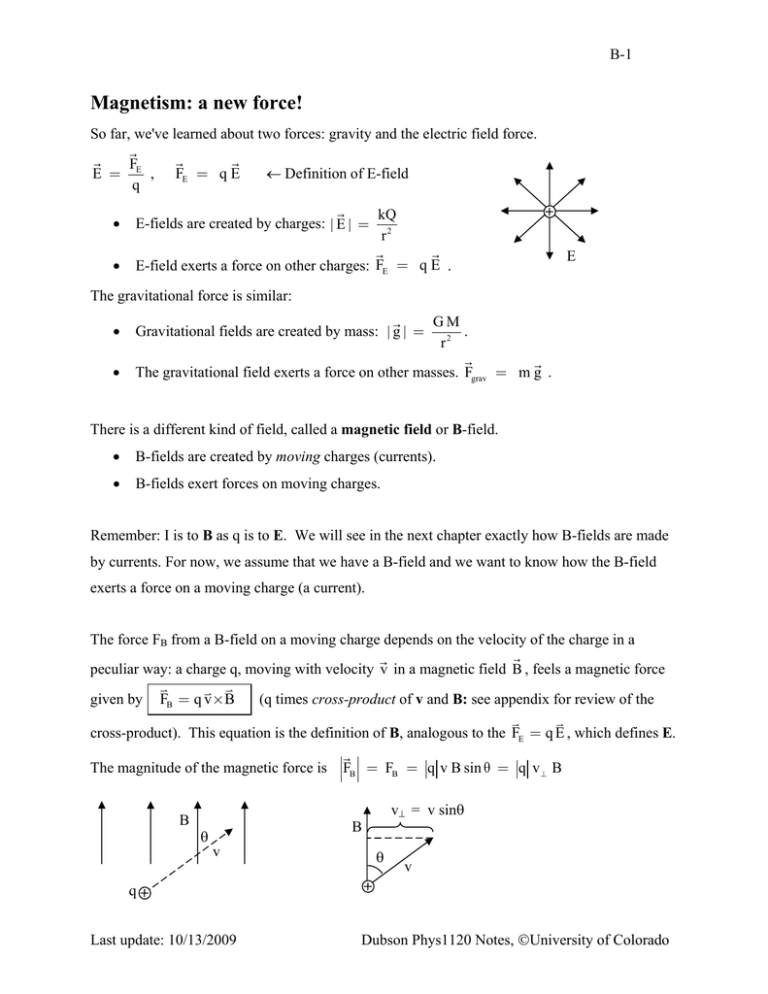
B-1 Magnetism: a new force! So far, we've learned about two forces: gravity and the electric field force. G G G G FE ← Definition of E-field E = , FE = q E q • • G kQ E-fields are created by charges: | E | = 2 r G G E-field exerts a force on other charges: FE = q E . E The gravitational force is similar: • • G GM Gravitational fields are created by mass: | g | = 2 . r G G The gravitational field exerts a force on other masses. Fgrav = m g . There is a different kind of field, called a magnetic field or B-field. • B-fields are created by moving charges (currents). • B-fields exert forces on moving charges. Remember: I is to B as q is to E. We will see in the next chapter exactly how B-fields are made by currents. For now, we assume that we have a B-field and we want to know how the B-field exerts a force on a moving charge (a current). The force FB from a B-field on a moving charge depends on the velocity of the charge in a G G peculiar way: a charge q, moving with velocity v in a magnetic field B , feels a magnetic force K K K given by FB = q v× B (q times cross-product of v and B: see appendix for review of the K K cross-product). This equation is the definition of B, analogous to the FE = q E , which defines E. G The magnitude of the magnetic force is FB = FB = q v B sin θ = q v⊥ B B v⊥ = v sinθ B θ v θ v q Last update: 10/13/2009 Dubson Phys1120 Notes, ©University of Colorado B-2 G G G The direction of the force FB is perpendicular to the plane formed by v and B . The direction of K K v×B is determined by the "Right-hand rule". Use your right hand. Point your fingers in the G G direction of v , curl your fingers toward B . (Orient hand so that fingers curl thru angle < 180o). G K K Your thumb then points in the direction of v×B , which is the direction of FB if the charge q is G positive. If q is (–), FB is other way v×B B v B q F (out) F (in) B v q v B F (in) v q (–) Unlike gravity or the electric force, the magnetic force is a velocity-dependent force. G G • If v ⊥ B , then sinθ = 1 ⇒ FB = |q| v B G G • If v & B , then sinθ = 0 ⇒ FB = 0 • If v = 0, then FB = 0 Units of B: [B] = [B] = (unlike gravity or E-field force) [F] N = = 1 tesla (T) m [q][v] C⋅ s Older, non-SI, unit of B: 1 gauss = 10-4 T , 1 T = 104 gauss • Earth's magnetic field ≈ 0.5 gauss = 5 × 10-5 T • kitchen magnet : 50 – 500 gauss = 0.005 – 0.05 T • iron core electromagnet: 2 T (max) (Strong enough to yank tools out of your hand.) • superconducting magnet: 20 T (max) Last update: 10/13/2009 Dubson Phys1120 Notes, ©University of Colorado B-3 We have said that currents make B-fields. So where's the current in a permanent magnet (like a compass needle)? An atom consists of an electron orbiting the nucleus. The electron is a moving charge, forming a tiny current loop –– an "atomic current". In most metals, the atomic currents of different atoms have random orientations, so there is no net current, no B-field. But in magnetic materials the atomic currents are aligned and they create a net current. (More on permanent magnets in the next chapter.) Motion of a charged particle in magnetic field Consider a charge q moving in a uniform magnetic field B. Since the force FB is always perpendicular to the velocity v, the force FB does no work : K G K K G K dr FB ⊥ v , v = ⇒ WFB = FB ⋅ dr = 0 . A magnetic force cannot change the KE of a dt particle (recall Work-KE theorem: Wnet = ∆KE). The B-field changes the direction of the velocity v, but does not change the speed, so we have v = constant. If the velocity v is perpendicular to the field B, the magnetic force bends the path of the particle in a circle. q v FB q FB v FB v B(out) uniform B (out) R FB v We can relate the radius R of the circular path to the magnitude of the field B and the speed v with Newton's Second Law: Last update: 10/13/2009 Dubson Phys1120 Notes, ©University of Colorado B-4 G G v2 Fnet = m a ⇒ q v B = m R Solving for R, we get R = G v2 ) ( recall that for circular motion a = R mv . Notice that the radius is proportional to the mass of the qB particle. In a mass-spectrometer, the mass of an unknown particle is determined from measurement of the radius (assuming charge, speed and B-field are all known). B Since the magnetic force has no component along the direction of B, there is no acceleration in that direction, and the component of the velocity along the direction of B is constant. Consequently, charged particles moving in a magnetic field can form spiral trajectories, spiraling around and along the B-field lines as shown. Charged particles (protons) from the sun (solar wind) are guided along the earth's B-field to arctic regions, where they slam into the atmosphere, producing "Northern lights". The Velocity Selector The velocity selector is a device which measures the speed v of an ion. (ion = charged atom with one or more electrons missing) . A magnet produces a uniform Bfield and a capacitor produces a uniform E-field, with E ⊥ B . Forces on charge: v E B(in) FB = q v B FE = q E mass m charge q uniform E down, B (in) The B and E fields are adjusted until the particle goes straight through. If the path is straight, then FB = FE ⇒ qvB = qE ⇒ v = E / B . Last update: 10/13/2009 Dubson Phys1120 Notes, ©University of Colorado B-5 Magnetic force on a current-carrying wire A B-field exerts a force on a moving charge. A current-carrying wire is full of moving charges, so a B-field exerts a force on the current-carrying wire. The force on a straight wire of length L, K K K carrying a current I, in a uniform magnetic field B, is given by F = I L × B , where we define a length vector L, having magnitude L = length of the wire and direction equal to the direction of the current in the wire. Proof: N moving charges K K K Force on a single charge = Fon q = q v × B . q area A Number of charges in wire = N = N n ⋅A ⋅L N #/ vol B v L volume K K K K K Total force on all the charges = Ftot = N q v × B = n A L q v × B Recall from the chapter on current that J = I = n q v ⇒ I = n q v A so A K K K K K Ftot = n A L q v × B = I L × B . Alternative proof: Let t is time for charge to move distance L, so speed of moving charges = v = L Nq , current I = . Assume B ⊥wire, just to simplify math. t t Fon wire = N ⋅ Fon q = N q vN B = L t I I B (uniform) Nq L B = I L B . Done. t N F = I L B ( B ⊥ I direction) L F (in) dF If wire is not straight or B is not uniform, then do that calculus thing: in your imagination, break the wire up K K K into little segments dL. d F = I dL × B , K K K K Ftot = ∫ d F = I ∫ dL × B Last update: 10/13/2009 I dL B (in) I Dubson Phys1120 Notes, ©University of Colorado B-6 Force on a Current Loop New term: "magnetic dipole moment" or "magnetic moment" = a loop of current magnetic moment µ = current × area µ µ= IA current I Direction of µ = direction of area vector A + right-hand rule: area A curl fingers of right hand in direction of current, thumb points along µ. (It's called a magnetic dipole moment because the B-field created by the current loop looks similar to the E-field created by an electric dipole. More on that in next chapter.) F Suppose loop is in a uniform B-field. Then Fnet = 0, always, since forces on opposite sides of loop will cancel. F B(out) F=IAB I µ θ B F I (in) a F But if µ is not parallel to B (loop not perpendicular to B) then there is a torque τ, F tending to twist the loop so that µ aligns with B. I (out) side view of loop It's not hard to show that the torque is K K K K K K K K τ = I A × B = µ × B . This equation τ = µ × B is the principle of operation of a galvanometer, which is a device that measure current: the greater the current, the greater the torque which causes a needle to rotate along a calibrated scale. Electric Motors An electric motor is a device which converts electrical energy into mechanical work. It consists of a rotating coil of wire carrying current I in a constant magnetic field B. (The B-field is made by a permanent magnet or by another coil of wire with current I .) Last update: 10/13/2009 Dubson Phys1120 Notes, ©University of Colorado B-7 The B-field exerts forces on the coil, causing it to F (out) rotate. After the coil rotates 180o, the current I reverses F (in) B (uniform) direction so that the force I always causes the coil to I rotation axis rotate in the same sense. So far, we have assumed the existence of B, and described the force on a moving charge due to that B. Now we will show how to make a B-field with a current. K K K Cross-Product Review: The cross-product of two vectors is a third vector A × B = C defined K K K K like this: The magnitude of A × B is A B sinθ . The direction of A × B is the direction perpendicular to the plane defined by the vectors A and B plus right-hand K K -rule. (Curl fingers from first vector A to second vector B, thumb points in direction of A × B A×B A θ B Last update: 10/13/2009 Dubson Phys1120 Notes, ©University of Colorado
